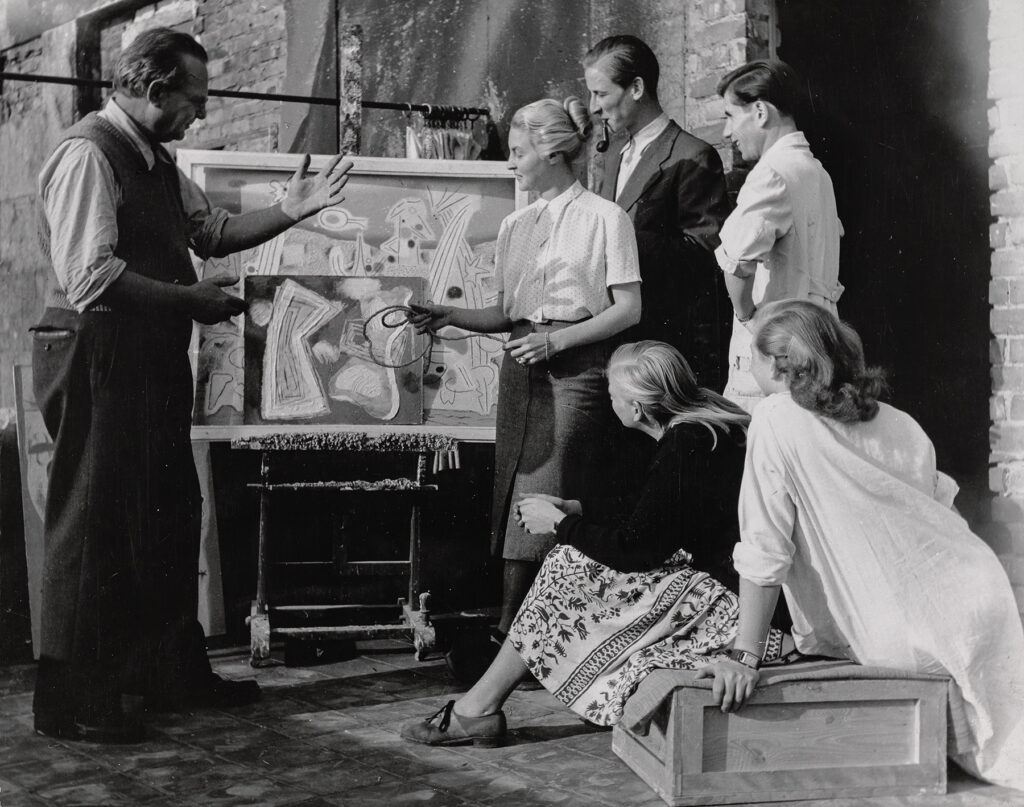Sophia-Maria von Waldthausen-Brede (1920–2010) attended Baumeister’s class from 1947 to 1950. After completing an additional course in architecture, she worked at the Stuttgart Department of Building Construction, later independently at Lake Starnberg.
Willi Baumeister worked with us, and we with him, in a small circle. When I came to him in January 1947, his contingent of students was … already full. I was taken on as a private student because I already had six semesters at the Hitler-oriented art academy in Dresden behind me. When the academy was not heated, classes took place in my lodgings or in my room where Karin Schlemmer resided with her mother and sister or in the studio of his house — later especially in the ruins. Working in a small circle generated a collegial togetherness. Reviewing consisted of a allowing for discovery, allowing for valisity, teaching and emptying were like breathing in and out. A fluidity between teaching, learning, and doing. The distribution of small tasks. Collaborative enterprises.
Willi Baumeister led us to our own decisions. His pedagogical potential completely agreed with his temperament. He was a good teacher – a lecturer he was not. Therefore I do not want to make any presumptions about his engagement in later mass operation. (Doris Kümmel said that 60–70 students filled the room when she paid Baumeister a visit at the academy.) It is thus difficult, if not impossible, to make generalizations. Moreover, at the time an age difference of six to eight years represented a break that was harder than that between generations. Add to this the then established freedom of consumption, market-oriented behavior, wanting to make money – a radical change in worldview followed, a substantial shift in mentality. In – as we now say – motivation.
Paul Baur commented: “It was an eminent political decision, after twelve years of philistinism and still the lingering character of it in the family, yes, in society, to steer away from this at your own risk.” I acted upon an intuitive need, a search for an adjustment factor, for intellectual and moral orientation. Willi Baumeister was completely unknown to me. I had never even seen one of his works. It sufficed that he had been ostracized. I took on a risk. Speculative intentions, such as participating in Baumeister’s international reputation, would not have had the slightest hold. The others, those released from concentration camps, soldiers, and also girls exempt from war service, had been led to Baumeister by a similar motivation.
We improvised our studies in an improvised academy that had restored itself to the conventional pattern nevertheless, whereby Baumeister, the uncertainty-factor, had nota bene to be integrated. We also represented an alien body. We were more likely to make contact with the architecture students than with fellow students in the other painting classes.
I hardly recall the first student-exhibition in 1949. I must have been away, bringing my textile designs to the man at fabric printers in Westphalia. If I was nonetheless present, it is only thanks to a colleague who took down a few of my works at my place and entered them in the exhibition.
Paul Baur: “All the other painting classes exhibited art – we, in contrast, mere study sheets, studies, experiments, analyses. Egon Kingerter attracted attention because he investigated a Rubens reproduction – The Three Graces – and dissected it according to picture composition, dynamics, light direction, and so on. This exhibition – Klaus Erler claimed to have seen it in Hamburg – might have been of significance for the academy’s history. For us it was not important – irrelevant – perhaps not even acceptable. To enter into competition with the painters of art? Consciously or unconsciously many of my colleagues refused to participate, as it turned out. Which in turn proves that we were interested in fundamental research, not in marketing.
(From a letter to Wolfgang Kermer dated September 29, 1990, quoted from Kermer 1992, p. 181)
